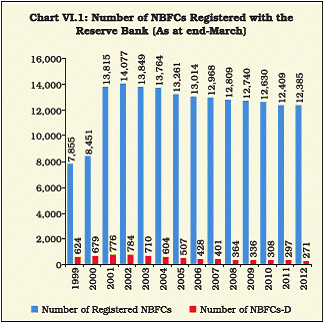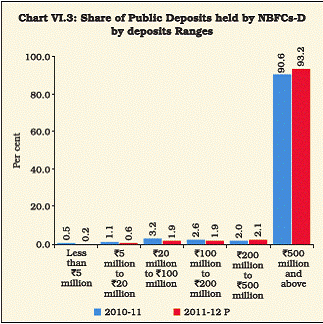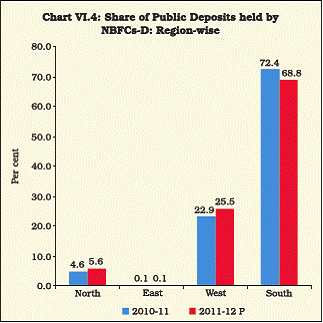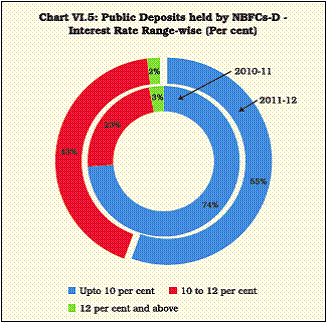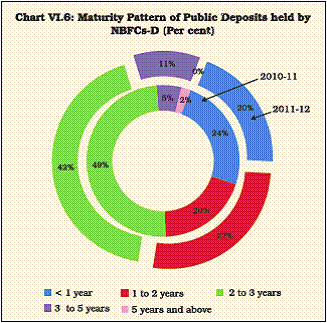 IST,
IST,
Non-Banking Financial Institutions
The non-banking financial sector is witnessing a consolidation process, with smaller NBFCs (deposit-taking) opting for either merger or closure and some larger ones getting converted into non-deposit-taking NBFCs. NBFCs are comfortably placed with higher capital. The financial performance of deposit-taking Non-Banking Financial Companies (NBFCs-D) showed an improvement as reflected in the increase in their operating profits mainly emanating from growth in fund-based income. Systemically Important-Non-deposit taking NBFCs (NBFCs-ND-SI) segment continued to rely on bank finances for their resource requirement. There is sign of deterioration in the quality of assets in respect of NBFCs-ND-SI. The set of regulations prescribed for NBFCs sector is expected to make the NBFCs more resilient in the medium term. The combined balance sheets of financial institutions (FIs) expanded and operating profit as well as net profit have increased significantly. The impaired assets of the FIs showed increase and are a matter of concern. The increase in expenses of PDs more than compensated for the increase in income which led to reduced profit. PDs are comfortably placed with higher CRAR. 1. Introduction 6.1 Non-banking financial institutions (NBFIs) are an important part of the Indian financial system. The NBFIs at present consist of a heterogeneous group of institutions that cater to a wide range of financial requirements. The major intermediaries include financial institutions (FIs), non-banking financial companies (NBFCs) and primary dealers (PDs). 6.2 This chapter provides an analysis of the financial performance and soundness indicators related to each segment of NBFIs during 2011-12. The chapter is organised into five sections. Section 2 analyses the financial performance of FIs, while Section 3 discusses the financial performance of NBFCs-D and NBFCs-ND-SI, including RNBCs. Section 4 provides an analysis of the performance of PDs in the primary and secondary markets, followed by the overall assessment in Section 5. 2. Financial Institutions 6.3 As at end-March 2012, there were five financial institutions (FIs) under the full-fledged regulation and supervision of the Reserve Bank, viz., Export Import Bank of India (EXIM Bank), National Bank for Agriculture and Rural Development (NABARD), National Housing Bank (NHB), Small Industries Development Bank of India (SIDBI) and Industrial Investment Bank of India (IIBI) (Table VI.1). However, IIBI is in the process of voluntary winding-up.
Operations of Financial Institutions Combined balance sheets of financial institutions (FIs) expanded 6.4 The financial assistance sanctioned and disbursed by FIs increased during 2011-12 due to increase in sanctions and disbursements made by investment institutions (LIC and GIC) and specified financial institutions (IVCF and TFCI). However, sanctions and disbursements made by IFCI have declined in 2011-12 (Table VI.2 and Appendix Table VI.1). Assets and Liabilities of FIs 6.5 The combined balance sheets of FIs expanded during 2011-12. On the liabilities side, deposits and ‘bonds and debentures’ remain the major sources of borrowings during 2011-12. On the assets side, ‘loans and advances’ continued to be the single largest component, contributing more than four-fifth of the total assets of the FIs (Table VI.3). Resources Mobilised by FIs Commercial Paper (CP) is the major source of funds 6.6 The resources mobilised by FIs during 2011-12 were considerably higher than in the previous year. The NHB has mobilised the largest amount of resources, followed by NABARD, SIDBI and EXIM Bank (Table VI.4). 6.7 During 2011-12, there was a significant increase in the resources raised by FIs through commercial paper (CP), which accounted for more than 70 per cent of the total resources mobilised from the money market (Table VI.5).
Sources and Uses of Funds 6.8 The majority of the funds raised were used for fresh deployments, followed by repayment of past borrowings (Table VI.6). Maturity and Cost of Borrowings and Lending 6.9 The weighted average cost of Rupee resources raised went up across the board. While the weighted average maturity of Rupee resources raised by SIDBI and NABARD has gone up, in the case of EXIM Bank and NHB they came down during 2011-12 (Table VI.7). While both EXIM Bank and SIDBI raised their prime lending rate during the year, the NHB kept it unchanged (Table VI.8). Financial Performance of FIs The profitability of FIs substantially increased with reduction in wage bill 6.10 Both the operating profit and net profit of FIs increased significantly during 2011-12 (Table VI.9). The return on assets (RoA) is highest for SIDBI followed by the NHB, EXIM Bank and NABARD (Table VI.10).
Soundness Indicators: Asset Quality NPAs of FIs have gone up substantially during the year 6.11 At the aggregate level, the net NPAs of FIs have increased substantially. The increase in net NPAs, however, was attributable mainly to SIDBI and EXIM Bank. While NABARD has maintained the same level, the NHB has reported no NPAs during 2011-12 (Table VI.11). 6.12 There was a substantial increase in the sub-standard and doubtful assets of EXIM Bank (Table VI.12). The higher NPAs in respect of EXIM Bank may be a reflection of the continued unfavourable external environment, especially in the context of India’s increased integration with the world economy. Capital Adequacy FIs are comfortably placed with capital 6.13 During the year 2011-12, all four FIs have maintained a higher CRAR than the minimum stipulated norm of 9 per cent (Table VI.13). 3. Non-Banking Financial Companies Three new categories of NBFCs have been created – Infrastructure Debt Funds (NBFC-IDF), Micro Finance Institution (NBFC-MFI) and NBFC-Factors 6.14 NBFCs are classified into two categories, based on the liability structure, viz., Category ‘A’ companies (NBFCs accepting public deposits or NBFCs-D), and Category ‘B’ companies (NBFCs not raising public deposits or NBFCs-ND). NBFCs-D are subject to requirements of capital adequacy, liquid assets maintenance, exposure norms (including restrictions on exposure to investments in land, building and unquoted shares), ALM discipline and reporting requirements; in contrast, until 2006 NBFCs-ND were subject to minimal regulation. Since April 1, 2007, non-deposit taking NBFCs with assets of `1 billion and above are being classified as Systemically Important Non-Deposit taking NBFCs (NBFCs-ND-SI), and prudential regulations, such as capital adequacy requirements and exposure norms along with reporting requirements, have been made applicable to them. The asset liability management (ALM) reporting and disclosure norms have also been made applicable to them at different points of time.
6.15 NBFCs are also classified in terms of activities into Asset Finance Companies (AFC), Investment Companies (IC), Loan Companies (LC), Infrastructure Finance Companies (IFC), Core Investment Companies (CIC), Infrastructure Debt Fund - Non-Banking Financial Companies (IDF-NBFC), Non-Banking Financial Company– Micro Finance Institutions (NBFC-MFI) and NBFC-Factors. During 2011-12, two new categories of NBFCs, viz., Infrastructure Debt Funds – NBFC (NBFC-IDF) and Micro Finance Institution (NBFC-MFI) – were created and brought under separate regulatory framework. In addition, a new category of NBFC-Factors was introduced in September 2012. Earlier in April 2010, a regulatory framework for Systemically Important Core Investment Companies (CIC NDSI) was created for companies with an asset size of `1 billion and above, whose business is investment for the sole purpose of holding stakes in group concerns, are not trading in these securities and are accepting public funds. Prudential requirements in the form of Adjusted Net Worth and leverage were also prescribed for CIC-ND-SIs as they were given exemption from NOF, capital adequacy and exposure norms. 6.16 An NBFC-MFI is defined as a non-deposit-taking NBFC (other than a company licensed under Section 25 of the Indian Companies Act, 1956) that fulfils the following conditions: (i) Minimum Net Owned Funds of `5 crore (`2 crore for the North-eastern Region), (ii) Not less than 85 per cent of its net assets are in the nature of “qualifying assets”, (iii) the income it derives from the remaining 15 per cent assets in accordance with the regulations specified in that behalf. An NBFC which does not qualify as an NBFC-MFI shall not extend loans to the micro finance sector, in excess of 10 per cent of its total assets. Given the functional hardship faced by the MFI sector following the Andhra Pradesh Micro Finance Institutions (Regulations of Money Lending) Ordinance, 2010 and to give reprieve to the sector, the Reserve Bank modified the regulatory framework for MFIs to allow for time for compliance to regulations and allow them to register with the Bank as NBFC-MFI early. Considering the importance of this sector for the development and regulation of micro-finance institutions to promote financial inclusion, the Micro-Finance Institutions (Development and Regulation) Bill, 2012 was introduced in the Lok Sabha on May 22, 2012 (Box VI.1). 6.17 The ownership pattern of NBFCs-ND-SI as well as deposit-taking NBFCs as at end-March 2012, suggested that government owned companies have a share of below 3 per cent (Table VI.14). Profile of NBFCs (including RNBCs) Non-Banking financial companies’ segment is witnessing consolidation 6.18 The total number of NBFCs registered with the Reserve Bank declined marginally to 12,385 as at end-June 2012 (Chart VI.1). A similar trend was observed in the case of deposit-taking NBFCs (NBFCs-D) during 2011-12, mainly due to the cancellation of Certificates of Registration (COR) and their exit from deposit-taking activities. 6.19 Despite the decline in the number of NBFCs, their total assets as well as net owned funds registered an increase during 2011-12, while public deposits recorded a decline. The share of Residuary Non-Banking Companies (RNBCs) in the total assets of NBFCs showed a decline. The net owned funds of RNBCs have however remained at more or less same level during 2011-12 (Table VI.15). Box VI.1:Micro Finance Institutions (Development and Regulation) Bill, 2012 and its Impact on the Microfinance Sector The Micro Finance Institutions (Development and Regulation) Bill, 2012 aims at providing a framework for the development and regulation of micro-finance institutions. The Bill defines a micro-finance institution (MFI) as an organisation, other than a bank, providing micro-finance services as micro credit facilities not exceeding `5 lakh in aggregate, or with the Reserve Bank’s specification of `10 lakh per individual. Subsidiary services like collection of thrift, pension or insurance services and remittance of funds to individuals within India also come under these services. The Bill allows the Central Government to create a Micro-Finance Development Council (MFDC) that will advise on policies and measures for the development of MFIs. Besides, the Bill allows the Central Government to form State Micro-Finance Councils (SMFC), which will be responsible for co-ordinating the activities of District Micro-Finance Committees in the respective states. District Micro-Finance Committees (DMFC) can be appointed by the Reserve Bank. The Bill requires all MFIs to obtain a certificate of registration from the Reserve Bank. The applicant needs to have a net owned fund (the aggregate of paid-up equity capital and free reserves on the balance sheet) of at least `5 lakh. The Reserve Bank should also be satisfied with the general character or management of the institution. Every MFI will have to create a reserve fund and the Reserve Bank may specify a percentage of net profit to be added annually to this fund. There can be no appropriation from this fund unless specified by the Reserve Bank. At the end of every financial year, MFIs are required to provide an annual balance sheet and profit and loss account for audit to the Reserve Bank. They will also have to provide a return, detailing their activities within 90 days of the Bill being passed. Any change in the corporate structure of a MFI, such as shut-down, amalgamation, takeover or restructuring can only take place with approval from the Reserve Bank. The Bill has entrusted the Reserve Bank with the power to issue directions to all MFIs. This could include directions on the extent of assets deployed in providing micro-finance services, ceilings on loans or raising capital. The RBI has the authority to set the ceiling on the rate of interest charged and the margin by MFIs. Margin is defined as the difference between the lending rate and the cost of funds (in percentage per annum). The Reserve Bank shall create the Micro-Finance Development Fund (MFDF). The sums are raised from donors, institutions and the public along with the outstanding balance from the existing Micro-Finance Development and Equity Fund. The central government, after due appropriation from Parliament, may grant money to this fund. The fund can provide loans, grants and other micro-credit facilities to any MFIs. The Reserve Bank is responsible for redressal of grievances for beneficiaries of micro-finance services. The Reserve Bank is empowered to impose a monetary penalty of up to `5 lakh for any contravention of the Bill’s provisions. No civil court will have jurisdiction against any MFI over any penalty imposed by the Reserve Bank. The Bill gives the Central Government the authority to delegate certain powers to the National Bank for Agriculture and Rural Development (NABARD) or any other Central Government agency. However, the Central Government has the power to exempt certain MFIs from the provisions of the Bill. The Bill and its likely Impact on the Microfinance Sector The Bill envisages that the Reserve Bank would be the overall regulator of the MFI sector, regardless of legal structure. The Reserve Bank has provided the views on the Bill to the Government of India. The aims of the Bill are to regulate the sector in the customers’ interest and to avoid a multitude of microfinance legislation in different states. The proper balancing of the resources at the Reserve Bank to supervise these additional sets of institutions besides the existing regulated institutions could be an important issue. Requiring all MFIs to register is a critical and necessary step towards effective regulation. The proposal for appointment of an Ombudsman will boost the banking industry’s own efforts to handle grievances better. Compulsory registration of the MFIs would bring the erstwhile money-lenders into the fold of organised financial services in the hinterland who had been acting as MFIs hitherto. 6.20 The ratio of public deposits of NBFCs to aggregate deposits of Scheduled Commercial Banks (SCBs) in 2011-12 indicates a decline. The ratio of deposits of NBFCs to the broad liquidity aggregate of L31 also declined during the year (Chart VI.2).
Operations of NBFCs-D (excluding RNBCs) Financial performance of deposit-taking Non- Bank Financial Companies (NBFCs-D) showed improvement 6.21 The balance sheet size of NBFCs-D expanded at the rate of 10.8 per cent in 2011-12 (Table VI.16). The borrowings constituted around two-third of the total liabilities of NBFCs-D. The public deposits of NBFCs-D, which are subject to credit ratings, continued to show an increasing trend during 2011-12. On the assets side, loans and advances remained the most important category for NBFCs-D, constituting about three-fourth of their total assets. The investment constituted the second most important category, which witnessed subdued growth during 2011-12 mainly due to a decline in non-SLR investments. 6.22 Asset Finance Companies (AFCs) held the largest share in the total assets of NBFCs-D at end-March 2012 (Table VI.17).
Size-wise Classification of Deposits of NBFCs-D Larger NBFCs are more successful in raising public deposits 6.23 A sharp increase was discernible in the share of NBFCs-D with a deposit size of ` 500 million and above, accounting for about 93.2 per cent of total deposits at end-March 2012. However, only 7 NBFCs-D belonged to this category, constituting about 3.6 per cent of the total number of NBFCs-D. It indicates that only relatively larger NBFCs-D were able to raise resources through deposits (Table VI.18 and Chart VI.3). Region-wise Composition of Deposits held by NBFCs 6.24 Among metropolitan cities, New Delhi accounted for the largest number of NBFCs-D, while Chennai held the largest share of 69.7 per cent in total public deposits of NBFCs-D (Table VI.19 and Chart VI.4).
Interest Rate on Public Deposits with NBFCs NBFCs-ND-SI segment continues to rely heavily on bank finance 6.25 There was an increase in the share of public deposits in the interest rate range of 10 per cent to 12 per cent during 2011-12 (Table VI.20 and Chart VI.5).
Maturity Profile of Public Deposits 6.26 The largest proportion of public deposits raised by NBFCs-D belonged to the short to medium end of the maturity spectrum. In 2011- 12, there was an increase in the shares of deposits for more than 2 years (Table VI.21 and Chart VI.6). 6.27 Banks and financial institutions were the major providers of funds for NBFCs-D, constituting about 50 per cent during 2011-12. This share has come down marginally. Others (which include, inter alia, money borrowed from other companies, commercial paper, borrowings from mutual funds and any other types of funds that were not treated as public deposits) also registered a declining trend (Table VI.22).
Assets of NBFCs Expansion in assets of AFCs was noticeable 6.28 The total assets of NBFCs-D sector registered a moderate growth during 2011-12 mainly due to an increase in the assets of asset finance companies (Table VI.23). As at end-March 2012, more than two-third of the total assets of the NBFCs-D sector was held by asset finance companies. Component-wise, advances accounted for the predominant share of total assets, followed by investment.
Distribution of NBFCs-D According to Asset Size 6.29 At end-March 2012, only 6 per cent of NBFCs-D had an asset size of more than ` 5,000 million, which had a share of 97 per cent in the total assets of all NBFCs-D (Table VI.24). Distribution of Assets of NBFCs – Type of Activity 6.30 During 2011-12, assets held in the form of loans and advances of NBFCs-D witnessed significant growth, whereas investment declined. These two categories of activities constituted over 90 per cent share in total assets of the NBFCs-D sector (Table VI.25). Financial Performance of NBFCs-D Fund-based income of the NBFCs-D segment has increased 6.31 The financial performance of NBFCs-D witnessed improvement as reflected in the increase in their operating profits during 2011-12. This increase in profit was mainly on account of growth in fund-based income (Table VI.26). Expenditure as a percentage to average total assets witnessed a marginal increase during 2011-12. The same trend is seen in terms of income as a percentage to average total assets of NBFCs-D (Chart VI.7).
Soundness Indicators: Asset Quality of NBFCs-D Deterioration in asset quality of NBFCs-D segment 6.32 During 2011-12, there was a significant increase in the gross NPAs to total advances of NBFCs-D, which is a deviation from recent trends. Net NPAs which remained negative till 2011 from 2008, with provisions exceeding NPAs registered an increase of 0.5 per cent of total net advances as on March 31, 2012 (Table VI.27). 6.33 There was deterioration in the asset quality of asset finance and loan companies during 2011-12 as evident from an increase in the gross NPAs to gross advances ratio for these companies (Table VI.28). In order to improve transparency and understanding by borrowers, the Reserve Bank has issued a revised fair practices code (Box VI.2).
Box VI.2: Guidelines on Fair Practices Code for NBFCs The Reserve Bank has revised the guidelines on Fair Practices Code (FPC) for all NBFCs issued on September 28, 2006 in the light of the recent developments in the NBFC sector. The salient features of the revised circular dated March 26, 2012 are as follows: General (a) All communications to the borrower shall be in the vernacular language or a language as understood by the borrower. (b) Loan application forms should include necessary information that affects the interests of the borrower. (c) Loan agreement should contain all details. (d) NBFCs should refrain from interference in the affairs of the borrower except for the purposes provided in the terms and conditions of the loan agreement. (e) In the matter of recovery of loans, the NBFCs should not resort to undue harassment and ensure that the staffs are adequately trained to deal with customers. (f) The Board of Directors of NBFCs should also lay down the appropriate grievance redressal mechanism within the organisation. (g) The Fair Practices Code should be put in place by all NBFCs with the approval of their Boards. The same should be put up on their website. (h) Boards of NBFCs should lay out appropriate internal principles and procedures to determine interest rates and processing and other charges. (i) The Board of each NBFC shall adopt an interest rate model taking into account relevant factors, such as cost of funds, margins and risk premium. (j) NBFCs must have a built-in re-possession clause in the contract/loan agreement with the borrower which must be legally enforceable. (k) To ensure transparency, the terms and conditions of the contract/loan agreement should also contain provisions regarding: (a) notice period before taking possession; (b) circumstances under which the notice period can be waived; (c) the procedure for taking possession of the security; (d) a provision regarding final chance to be given to the borrower for repayment of loan before the sale / auction of the property; (e) the procedure for giving repossession to the borrower and (f) the procedure for sale/ auction of the property. NBFC-MFIs In addition to the general principles above, NBFC-MFIs are required to adopt the following fair practices that are specific to their lending business and regulatory framework. (a) A statement shall be made in vernacular language and displayed by NBFC-MFIs in their premises and in loan cards articulating their commitment to transparency and fair lending practices; (b) Field staff should be trained to make necessary enquiries with regard to existing debt of the borrowers, and training, if any, offered to the borrowers shall be free of cost. (c) The effective rate of interest charged and the grievance redressal mechanism set up by the NBFC-MFIs should be prominently displayed in all its offices; (d) A declaration that the MFI will be accountable for preventing inappropriate staff behaviour and timely grievance redressal shall be made in the loan agreement; (e) All sanctioning and disbursement of loans should be done only at a central location and more than one individual should be involved in this function; (f) All NBFC-MFIs shall have a Board-approved standard form of loan agreement, preferably in the vernacular language; (g) The loan card should reflect the details, including the effective rate of interest charged; (h) Non-credit products issued shall be with the full consent of borrowers and the fee structure shall be communicated in the loan card itself; (i) Recovery should normally be made only at a central designated place; (j) NBFC-MFIs shall ensure that a Board-approved policy is in place with regard to Code of Conduct by field staff. Lending against collateral of gold jewellery (a) Adequate steps to ensure that the KYC guidelines stipulated by the RBI are complied with and to ensure that adequate due diligence is carried out on the customer before extending any loan. (b) Proper assaying procedure for the jewellery received. (c) Internal systems to satisfy ownership of the gold jewellery. (d) The policy shall also cover putting in place adequate systems for storing the jewellery in safe custody, reviewing the systems on an on-going basis, training the concerned staff and periodic inspection by internal auditors to ensure that the procedures are strictly adhered to. (e) Loans against the collateral of gold should not be extended by branches that do not have appropriate facility for storage of the jewellery. (f) The jewellery accepted as collateral should be appropriately insured. (g) The Board-approved policy with regard to auction of jewellery in case of non-repayment shall be transparent and adequate prior notice to the borrower should be given before the auction date. (h) The auction should be announced to the public by issue of advertisements in at least 2 newspapers, one in vernacular language and another in national daily newspaper. (i) As a policy the NBFCs themselves shall not participate in the auctions held. (j) Gold pledged will be auctioned only through auctioneers approved by the Board. (k) The policy shall also cover systems and procedures to be put in place for dealing with fraud, including separation of duties of mobilisation, execution and approval. 6.34 There was an increase in the shares of all three NPA categories of sub-standard, doubtful and loss assets of all companies in 2011-12, underlining the marginal deterioration in asset quality of these institutions. This mainly emanated from asset finance companies (Table VI.29). 6.35 At end-March 2012, of 190 reporting NBFCs, 187 had CRAR of more than 15 per cent (Table VI.30). This could be an indication that the NBFC sector is undergoing a consolidation process in the past few years, wherein weaker NBFCs are gradually exiting and paving the way for stronger ones. The ratio of public deposits to Net Owned Funds (NOF) of NBFCs taken together has more or less remained same as at end-March 2012 (Table VI.31). There was a significant increase in NOF and public deposits of NBFCs-D during 2011-12. The increase in NOF was mainly concentrated in the category of `5,000 million and above (Table VI.32).
Residuary Non-Banking Companies (RNBCs) RNBCs are in the process of migrating to other business models 6.36 The assets of RNBCs declined by 34 per cent during the year ended March 2012. The assets mainly consist of investments in unencumbered approved securities, bonds/ debentures and fixed deposits/certificates of deposit of SCBs. The NOF of RNBCs has also registered a decline of 52.2 per cent in 2011-12 (Table VI.33). The decline in the expenditure of RNBCs during 2011-12 was more than the decline in income, as a result of which the operating profits of RNBCs increased during the year. As a result of decline in the provision for taxation, the net profits of RNBCs increased sharply during 2011-12.
Regional Pattern of Deposits of RNBCs 6.37 At end-March 2012, there were two RNBCs, registered with the Reserve Bank. One each is located in central and eastern regions. Both the RNBCs are in the process of migrating to other business models and have been directed to reduce their deposit liabilities to ‘nil’ by 2015. Public deposits held by the two RNBCs registered a significant decline in 2011-12, mainly due to a substantial decline in the deposits held by SIFCL (Table VI.34). Investment Pattern of RNBCs 6.38 Following the decline in deposits, there was a decline in the investments of RNBCs in 2011-12. The decline was noticeable in all segments of investment (Table VI.35).
NBFCs-ND-SI Though borrowing from banks is sizable, a substantial increase in borrowings by way of debentures was witnessed 6.39 The assets of NBFCs-ND-SI for the year ended March 2012 showed an increase of 21 percent. Total borrowings (secured and unsecured) by NBFCs-ND-SI showed a significant increase of 23.6 per cent, constituting more than two-third of the total liabilities (Table VI.36). Secured borrowings constituted the largest source of funds for NBFCs-ND-SI, followed by unsecured borrowings, reserves and surplus. 6.40 The NBFCs-ND-SI segments is growing rapidly. Borrowings comprise their largest source of funds, mostly sourced from banks and financial institutions. To the extent that they rely on bank financing, there is an indirect exposure to depositors. While the concentration of funding has risks, the caps on bank lending to NBFCs may constrain their growth. However, the leverage ratio of the NBFCs-ND-SI sector remains the same as in the previous year.
Borrowings of NBFCs-ND-SI by Region Northern Region continued to be main source of funds 6.41 Analysis of region-wise borrowings of the NBFCs-ND-SI reveals the dominance of northern and western regions; together they constitute more than 70 per cent of the total borrowings during the year ended March 2012. The same trend continued during the quarter ended June 2012. All regions registered growth during both the year ended March 2012 and quarter ended June 2012 (Table VI.37). Financial Performance NBFCs-ND-SI showed deterioration in financial performance and increase in NPAs 6.42 The financial performance of the NBFCs- ND-SI sector deteriorated marginally as reflected in the decline in net profit during 2011-12 (Table VI.38). Both Gross and Net NPAs to total asset of the NBFCs-ND-SI sector increased during the year. The same trend continued as on June 2012 (Table VI.39).
6.43 As on March 31, 2012, the majority of the reporting companies maintained the stipulated minimum norm of 15 per cent capital adequacy as measured by CRAR. Only 10 per cent of the total reporting companies have a CRAR of less than 15 per cent (Table VI.40). These companies were also largely dependent on nationalised banks for their term loans, working capital loans and debentures/CPs. New private sector banks have emerged as a second major bank group for these companies to raise term loans and working capital loans (Table VI.41).
4. Primary Dealers 6.44 There were 21 Primary Dealers (PDs) operating in the financial markets as on June 30, 2012. Of them, 13 were run by banks as a department called Bank-PDs, and the remaining 8 were non-bank entities known as standalone PDs registered as NBFCs under Section 45 IA of the RBI Act, 1934. Operations and Performance of PDs 6.45 During 2011-12, the bid to cover ratio of PDs in both dated Government of India securities (G-Sec) and Treasury Bills (T-Bills) was marginally lower than in the previous year. PDs were required to achieve a minimum success ratio (bids accepted to the bidding commitment) of 40 per cent for T-Bills and Cash Management Bills (CMBs) put together, usually reviewed on a half-yearly basis. All the PDs achieved the stipulated minimum success ratio in both the first and second half of 2011-12. The success ratio in T-Bill auctions, however, was marginally lower during the year. 6.46 During 2011-12, all the dated G-Secs were fully underwritten. In the auctions of dated securities, the share of the PDs (bids accepted to the securities issued) decreased marginally (Table VI.42). Partial devolvement on the PDs took place on 14 instances.
Performance of Standalone PDs 6.47 In the secondary market, PDs have individually achieved a minimum annual total turnover ratio2 (outright and repo transactions) of 5 times in dated G-Sec and 10 times in T-Bills during 2011-12. PDs had also achieved the minimum annual outright turnover ratio of 3 times in dated G-Sec and 6 times in T-Bills (Table VI.43).
Sources and Application of Funds of Standalone PDs Investment by PDs in corporate bond market has decreased 6.48 The net owned fund (NOF) of the PDs has increased marginally. Reserves and surplus of the PDs had increased significantly. Both the secured and unsecured loans of the PDs also increased significantly during 2011-12. Investments in corporate bonds decreased marginally during the year (Table VI.44). Financial Performance of Standalone PDs Sharp increase in expenses led to reduction in profit 6.49 The net profit of the PDs reduced marginally during 2011-12. The total income of the PDs increased significantly. However, the PDs reported a sharp increase in their interest expenses mainly due to the increased cost of borrowings (Table VI.45). As a result, the cost-income ratio (i.e., operating expenses to net total income) increased during the year. The return on net worth (RONW) and return on average assets (ROAA) for the year ended March 2012 were down marginally (Table VI 46). The CRAR of the PDs increased from 46.2 per cent to 53.8 per cent during the year as against a minimum prescribed requirement of 15 per cent (Table VI 47).
5. Overall Assessments 6.50 There were signs of a consolidation process in the NBFC sector in terms of number of NBFCs. The balance sheets of NBFCs have, however, showed substantial expansion and similar expansion was observed in respect of FIs and PDs. The financial performance of the NBFCs-D segment has witnessed improvement as reflected in the increase in their operating profits mainly emanating from fund-based income. However, the financial performance of the NBFCs-ND-SI segment has deteriorated marginally, though the sector is growing faster. Borrowings constitute the largest source of funds mostly sourced from banks and financial institutions for NBFCs. Thus, the heavy reliance on bank financing needs to be monitored closely. In this context, the recent regulatory measures leading to tightening of norms with respect to raising of resources from banks is expected to bring down the NBFC sector’s reliance on the banking sector and to look for alternate sources of funds. 6.51 In terms of NPAs, there was a significant increase in the gross NPAs to total advances of NBFCs. Similarly, FIs have registered an increase in NPAs. The NBFIs as a segment continue to be better placed in terms of capital adequacy with high CRAR than the minimum regulatory requirement. In respect of primary dealers, while their interest income increased, expenses enhanced at a faster pace due to the increased cost of borrowings, leading to reduced profit and lower RoA. 1 Includes NM3 + Postal Deposits + Term Money + Certificates of Deposit + Term Deposit + public deposits with NBFCs. |
|||||||||||||||||||||||||||||||||||||||||||||||||||||||||||||||||||||||||||||||||||||||||||||||||||||||||||||||||||||||||||||||||||||||||||||||||||||||||||||||||||||||||||||||||||||||||||||||||||||||||||||||||||||||||||||||||||||||||||||||||||||||||||||||||||||||||||||||||||||||||||||||||||||||||||||||||||||||||||||||||||||||||||||||||||||||||||||||||||||||||||||||||||||||||||||||||||||||||||||||||||||||||||||||||||||||||||||||||||||||||||||||||||||||||||||||||||||||||||||||||||||||||||||||||||||||||||||||||||||||||||||||||||||||||||||||||||||||||||||||||||||||||||||||||||||||||||||||||||||||||||||||||||||||||||||||||||||||||||||||||||||||||||||||||||||||||||||||||||||||||||||||||||||||||||||||||||||||||||||||||||||||||||||||||||||||||||||||||||||||||||||||||||||||||||||||||||||||||||||||||||||||||||||||||||||||||||||||||||||||||||||||||||||||||||||||||||||||||||||||||||||||||||||||||||||||||||||||||||||||||||||||||||||||||||||||||||||||||||||||||||||||||||||||||||||||||||||||||||||||
Page Last Updated on:






